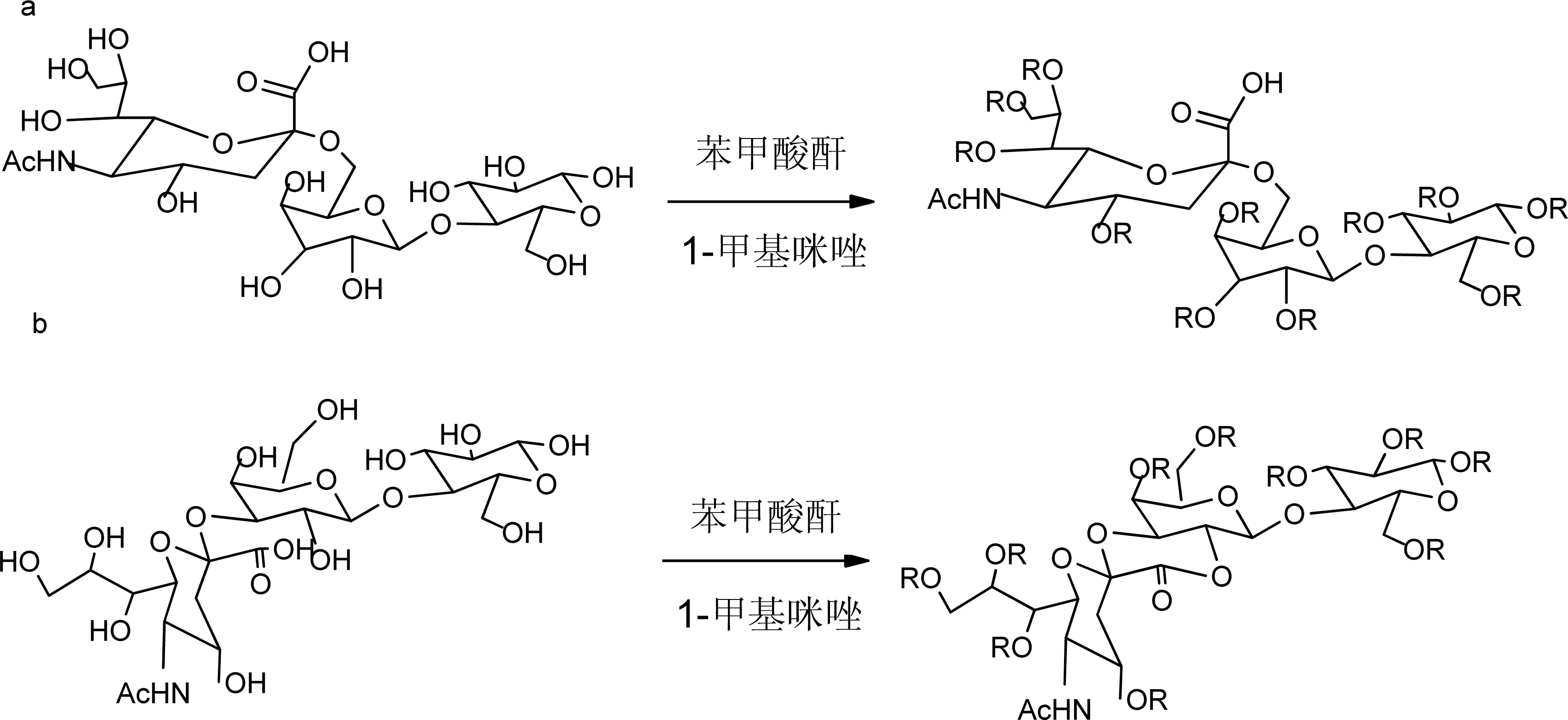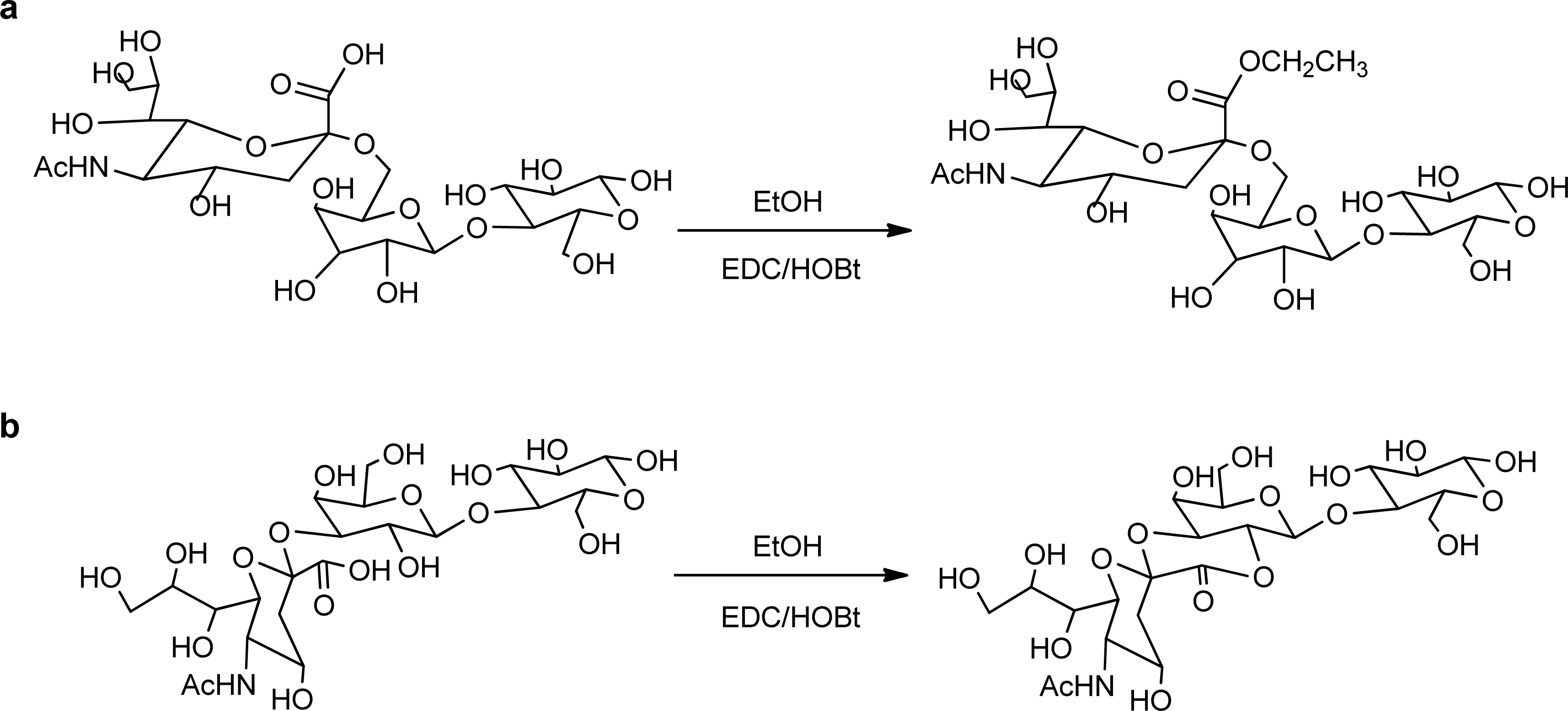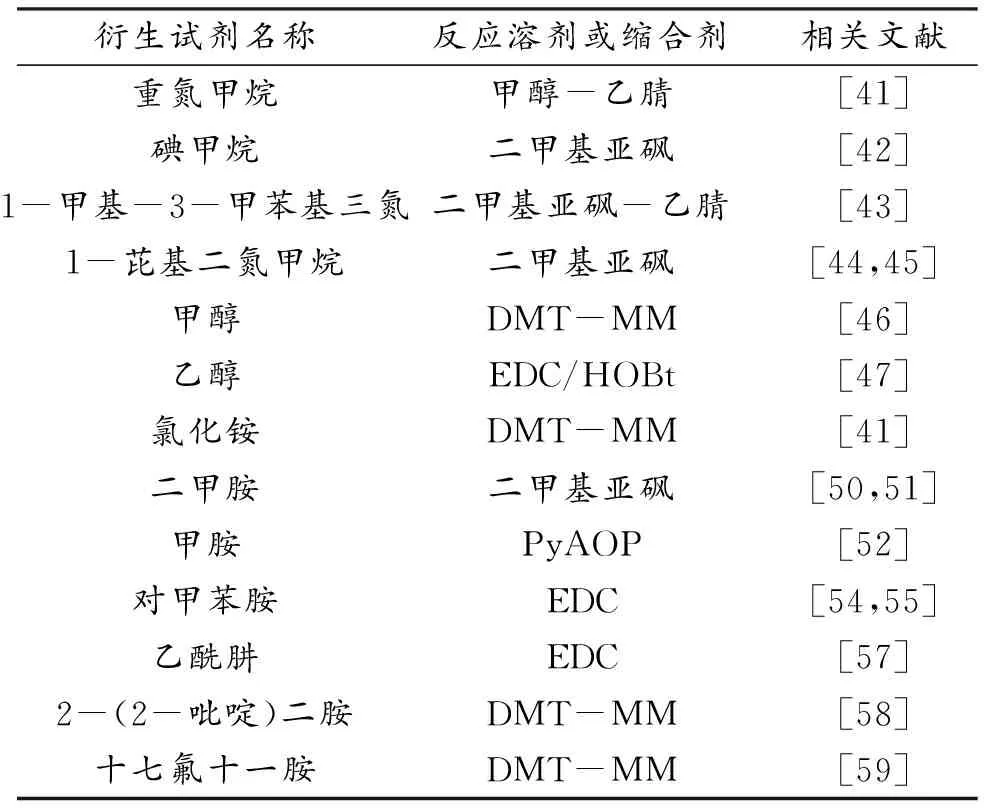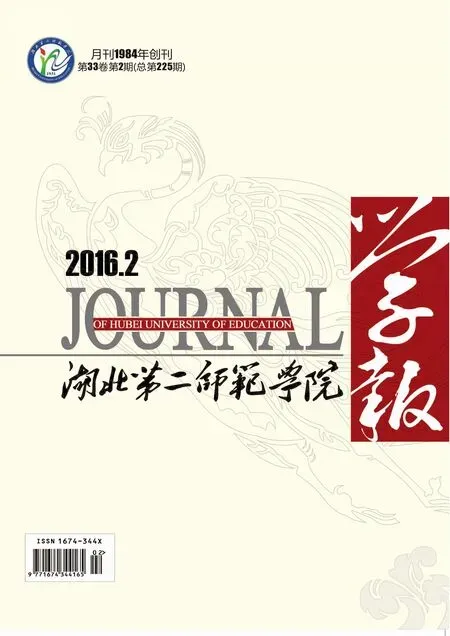基于化学衍生的MALDI质谱法分析唾液酸化聚糖
杜迎新,林亚维
(武汉理工大学 化学化工与生命科学学院, 武汉 430070)
基于化学衍生的MALDI质谱法分析唾液酸化聚糖
杜迎新,林亚维
(武汉理工大学 化学化工与生命科学学院, 武汉 430070)
摘要:唾液酸广泛存在于聚糖的末端,不仅参与细胞信号传导、细胞粘附以及特异性识别等重要生理过程,还与癌症等重大疾病密切相关。因此,分析生物体系中的唾液酸化聚糖具有十分重要的意义。MALDI质谱具有灵敏度高、可以直接测定分子量等优点,已成为检测糖链的重要工具之一,但该方法直接检测生物样品中的唾液酸聚糖链仍存在诸多的困难,必须对其进行适当地衍生。常用衍生化方法可通过引入带电基团或疏水基团,以此增强聚糖的色谱分离、离子化效率或防止检测过程中唾液酸残基的丢失。本文主要针对从糖缀合物中解离下的唾液酸化聚糖样品,总结、概述了最近涌现的各种衍生化技术与相应的MALDI质谱检测方法。
关键词:唾液酸化糖链;化学衍生;MALDI质谱法
蛋白质糖基化是基因在转录和翻译后最广泛、最复杂、最重要的修饰之一,而目前已知真核蛋白中超过半数的蛋白存在糖基化修饰。这些糖蛋白广泛分布于细胞、组织及体液中,特别是在细胞膜上和体液中表达广发。比如,人们把细胞外壁表达显著的聚糖称之为“糖被Glycocalyx”,它们与细胞的易裂、细胞-细胞相互作用等重要行为紧密相关,在细胞分化、发育、肿瘤发生与转移、精卵识别、免疫、传染及再生中发挥着重要的作用。因此,糖链的分析与检测已成为当前糖组学研究中最重要的领域之一。

图1 唾液酸类化合物的结构图
唾液酸(SA)是一类具有9碳糖结构的神经氨酸衍生物(图1),自然界中,通常作为“信号分子”连接在细胞膜寡糖侧链的非还原末端,形成唾液酸聚糖、唾液酸糖肽和唾液酸糖蛋白;游离的唾液酸主要存在3种形式,即N-乙酰神经氨酸(Neu5Ac)、N-羟乙酰神经氨酸(Neu5Gc)、去氨基神经氨酸(KDN)。唾液酸4号位、7号位、8号位、9号位碳原子上的羟基可被甲基、乳酰基、硫酸和磷酸等基团取代形成多种同系物[1-4],目前发现的天然唾液酸已经超过60种。在N-糖链与O-糖链的末端都发现有唾液酸单元,它们与糖链的联接方式为:唾液酸2号碳原子上的羟基可通过α2-(3/4/6)与半乳糖(Gal)相连;通过α2-(3/6)与N-乙酰半乳糖胺(GalNAc)相连;α2-6与N-乙酰葡糖胺(GlcNAc)相连;α2-(8/9)与唾液酸分子相连[5-8]。多种链接方式形成不同种类的唾液酸糖链和唾液酸聚糖。
早期报道指出,唾液酸化聚糖与癌症有着密切联系:比如,胃癌晚期患者胃液中唾液酸聚糖、结肠癌和淋巴瘤患者血浆中唾液酸聚糖含量高于正常人[9-10]。随着深入研究发现,不同病理周期黑色素瘤和肺癌患者血清中唾液酸化聚糖的含量有明显的变化[11-12];红细胞表面唾液酸化聚糖对其生长、衰老、吞噬起重要的调控作用[13-14];唾液酸羧基的电负性和末端三醇边链结构是维持细胞膜表面Ca2+稳态的重要因素[15-16],并且与神经突触的传递和神经系统的发育息息相关[17]。
鉴于唾液酸化聚糖的重要性,半个世纪以来,国内外学者对它展开了广泛研究[18-20];尤其近十几年,随着现代分析测试技术,例如MALDI(基质辅助激光解吸)质谱、液相色谱-质谱联用技术( LC-MS)[21-23]、荧光高效液相色谱技术(HPLC-FD)[22]和高效阴离子交换-脉冲安培检测法(HPAE-PAD)[25-26]、核磁共振法(NMR)[24]等发展的日趋成熟,唾液酸聚糖研究在分离纯化、荧光标记、质谱检测等方面取得了突破性进展。其中MALDI(基质辅助激光解吸)质谱法以其灵敏度高,能产生具有结构信息的离子碎片,分析速度快等优势,目前已成为检测唾液酸化聚糖的最主要方法之一。然而,MALDI质谱法直接对唾液酸化糖链进行分析,依然存在诸多困难。这可归咎为以下几个因素:(1)待测生物样品中唾液酸的丰度值相对较低,且信号易被其他种类的生物分子或污染物抑制;(2)唾液酸糖苷键在MALDI质谱检测过程中可能发生断裂,导致唾液酸化糖链中唾液酸残基的解离或者丢失;(3)唾液酸分子本身结构的特殊性,例如,弱酸性、强极性、基团迁移等决定了在MALDI质谱分析唾液酸化聚糖前可对其进行适当地衍生和修饰,从而达到唾液酸化聚糖高灵敏度、高选择性的准确分析[27-29]。本文主要对最近涌现的多种适用于MALDI质谱分析的唾液酸化聚糖衍生方法进行了介绍和总结。其中,唾液酸化聚糖的衍生化方法大致归为:泛衍生化反应、针对羧基的酯化与酰胺化衍生反应。接下来,我们将重点介绍这几种方法的研究进展,总结目前适用于MALDI质谱分析的唾液酸化聚糖各种衍生方法,并对评述它们的原理及应用范围。
1唾液酸化糖链衍生化方法
1.1泛衍生化反应


图2 唾液酸泛甲基化反应
泛苯甲酰基化也是分析唾液酸聚糖样品中常用的衍生方法,与泛甲基化比较,其优点在于可以明显改善聚糖在反相色谱上的分离性能,便于紫外检测[36]。Chen等[37]将苯甲酸酐与Neu5Acα2-3、α2-6Gal低聚糖单元在1-甲基咪唑溶液中110°C反应5h,实验表明,泛苯甲酰基化衍生后的唾液酸残基在MALDI质谱检测中的稳定性显著提高,通过清晰MALDI质谱图可以分析和鉴别皮摩尔水平的α2,3和α2,6连接的唾液酸化聚糖(图 3)。尽管如此,泛苯甲酰基化衍生时间相对较长,室温下很难达到理想的衍生效果,且唾液酸羧基未能参与反应,仍需进一步酯化处理,因此这种方法未能被广泛使用。

图3 唾液酸泛苯甲酰基化反应: a.苯甲酸酐与Neu5Acα2,3Gal聚糖的反应;b.苯甲酸酐与Neu5Acα2,6Gal聚糖的反应
2唾液酸羧基的衍生反应
由于末端唾液酸残基中羧基的存在会导致其糖苷键的不稳定,在MALDI质谱分析过程中往往会导致唾液酸的解离或丢失[3,38]。电喷雾电离(ESI)中也会降低唾液酸聚糖的离子化效率和质谱信号强度[39,40]。因此,通过对唾液酸羧基化学衍生使唾液酸聚糖呈电中性,从而获得样本完整的结构信息是处理唾液酸样品常用的方法,以下我们将介绍针对唾液酸羧基的几种主要衍生方法。
2.1羧基酯化反应

图4 唾液酸羧基酯化反应
羧基酯化反应是提高唾液酸聚糖稳定性一种行之有效的方法(图 4)。Hakomori[41]等最先尝试用高活性的重氮甲烷与AG50(H+)酸化的唾液酸化聚糖在甲醇-乙醚溶液中反应。反应过程中,首先亚甲基夺取羧基的氢质子,然后带负电荷的羧基进攻质子化的重氮甲烷,随即离去一个氮分子,得到甲酯化产物,此反应具有速率高、连续性强等优点,但是由于重氮甲烷的不稳定性,使其应用受到局限。
碘甲烷作为常见的亲电甲基化试剂,可以使羧基氢质子甲基化。Harvey等[42]将唾液酸聚糖先经过AG50(Na+)离子交换层析柱,转化为离子态,然后与碘甲烷在室温条件下快速反应得到产物,首次成功地将唾液酸甲酯化反应用于MALDI质谱分析中;此方法可以消除不稳定质子,抑制唾液酸残基的丢失,得到更加清晰质谱图。在此基础之上,Li等[38]采用“一锅法”将酶解、纯化后的N-聚糖中唾液酸的羧基甲酯化;结果表明,与未衍生的N-聚糖相比,处理后的唾液酸化聚糖检测灵敏度可以提高约10倍。
Nishimura[43]等使用“糖印迹”(glycoblotting)技术,将1-甲基-3-对甲苯基三氮(MTT)与唾液酸化聚糖的金胶体纳米粒子载体发生“固相甲基化”反应,不仅避免使用易挥发、毒性强、危险性大的试剂,如碘甲烷和重氮甲烷等,同时减少了MALDI-TOF MS中阳离子种类和数量,获得高灵敏度和高分辨率的质谱信号。
糖肽中的唾液酸化聚糖具有强亲水性,抑制了其在MALDI质谱中的电离能力,为了增强天然唾液酸糖链在质谱中的离子化效率,Amano[44]等以DMSO为溶剂,羧基作为亲核试剂进攻强疏水性试剂1-芘基二氮甲烷(PDAM)上叠氮相连的活性C原子,同时离去一分子氮,生成带有芘基的疏水性唾液酸衍生物。衍生化处理后, MALDI-MS能够检测出源自1ng前列腺特异性抗原中的唾液酸糖肽衍生物。进一步研究发现[45],PDAM衍生之后的α2,3和α2,6唾液酸聚糖异构体在MALDI产生不同CID离子碎片,这种特异性电离模式,可用于快速区别两种不同连接方式的唾液酸聚糖。
Hincapie等[46]首先使用4-(4,6-二甲氧基三嗪-2-基)-4-甲基吗啉盐酸盐(DMT-MM)为偶联剂,N-聚糖与甲醇溶液在80°C 下反应1 h,可得到高转化率的甲酯化衍生产物。最近,Reiding等[47]选用1-(3-二甲氨基丙基)-3-乙基碳二亚胺盐酸盐,1-羟基苯并三唑(EDC/HOBt)为羧基活化剂,使唾液酸化聚糖与乙醇的酯化反应温度降低一半,酯化产率更高。值得强调的是,此类反应具有高度区域专一性,α2-6连接的唾液酸化聚糖与乙醇发生酯化反应(图5 a),而α2-3连接唾液酸聚糖的唾液酸分子与相邻的半乳糖(Gal)4号位羟基发生酯化反应,形成六元环内酯 (图5 b),这种特异性的酯化方式可以提高唾液酸化聚糖在亲水相互作用色谱法(HILIC)中的分离效率,并且由于衍生产物分子量的差异,从而能准确的测定糖链中唾液酸的连接方式,具有很大的应用价值及前景。

图5 唾液酸与乙醇的酯化反应: a. α2-6连接的唾液酸化聚糖与乙醇发生酯化反应; b. α2-3连接唾液酸聚糖与相邻的半乳糖(Gal)4号位羟基反应,形成六元环内酯。
2.2羧基酰胺化反应
酯类化合物在强酸或强碱性条件易发生水解反应,其稳定性远远不如酰胺结构。酰胺键的形成能够稳定唾液酸与多糖之间的糖苷键,抑制MALDI过程中唾液酸残基的丢失。诸多报道指出,唾液酸乙酰氧基易发生基团迁移或者解离[48,49],同酯化反应一样,酰胺化(图 6)也是唾液酸衍生中重要方法。

图6 唾液酸羧基的酰胺化反应
Sekiya等[50]以DMT-MM为缩合剂,唾液酸化聚糖与NH4Cl在弱酸性条件下反应,生成酰胺;研究表明,酰胺反应能够抑制Neu5Acα2-6Gal糖苷键源内裂解(ISD)、源后裂解(PSD)、碰撞诱导解离(CID)过程中的断裂,明显提高质谱检测中聚糖的电离效率。Novotny等[51]综合运用酰胺化反应和泛甲基化两种衍生方法。研究表明,α2-3连接的唾液酸聚糖经过六元环内酯中间产物最终在泛甲基化条件下开环得到羧酸甲酯,而α2-6连接的唾液酸聚糖先由酰胺化反应生成酰胺基最后经过泛甲基化得到二甲基酰胺结构,两种糖类异构体经过衍生之后在MALDI-TOF MS中质荷比相差13 Da。通过上述方法很容易鉴别出乳癌患者血清中两种不同连接方式的唾液酸化糖肽的相对含量。
最近,Wuhrer[52]等将血浆中免疫球蛋白G(IgG)经酶解、分离、纯化后得到的唾液酸糖肽与二甲胺在EDC/HOBt 的DMSO溶液中反应(Table 2b);MALDI-TOF-MS表明,α2-3连接的唾液酸化糖肽在1号位形成六元环内酯,而α2-6的连接的唾液酸化糖肽形成二甲基酰胺结构,这种新的衍生方法可以有助于分析医疗性抗体中糖基化位点和唾液酸特异性的连接方式。
α2-3连接的唾液酸化聚糖羧基与相邻单糖的羟基的空间位阻效应和分子内氢键使得酸性条件下其更趋于发生分子内酯化反应,酰胺化反应活性远远低于α2-6连接的唾液酸聚糖[53]。基于此,Li等[54]选用一种高性能磷正离子PyAOP作为酰胺缩合剂,室温条件下,唾液酸羧基与甲胺脱水缩合,生成甲胺化衍生产物。这种衍生方法不仅解决了MALDI-TOF过程中唾液酸残基丢失和乙酰氧基迁移等问题,同时对α2,3、α2,6连接的唾液酸聚糖均表现出很高的反应活性。Nishikaze等[55]用类似的方法,实现了甲胺盐酸盐与唾液酸糖肽的甲胺化,这种衍生方法一方面防止质谱检测中唾液酸残基的损失,减少唾液酸化糖肽和非唾液酸化糖肽之间离子化效率的差异,从而以正离子CID测定肽链序列与糖链结构,负离子CID提供聚糖糖基化位点信息;另一方面,甲胺化衍生还能够固定唾液酸聚糖在液相色谱中的保留时间、改善其色谱峰的峰形以及ESI-MS中重现性和检测灵敏度。经过甲胺化衍生,Liu等[56]使用纳升级液质联用技术NanoLC-MS以PGC为固定相从正常人血清样品中找出293种不同的N-糖链和7种二天线唾液酸糖链的异构体。
Zhang[57]等用EDC为偶联剂,在pH=4.5条件下,对甲苯胺作为酰胺化试剂固定唾液酸残基;实验证明,此衍生反应不仅可以有效地增强聚糖在MALDI-TOF质谱中的离子化效率,而且提高了唾液酸聚糖的疏水性,有利于其在C18柱中良好地分离。
唾液酸化糖蛋白样品一般前处理方法是酶解法释放出唾液酸化糖链,然而游离的聚糖末端醛基也可以与酰肼类化合物反应,以致不能产生具有稳定专一结构的目标衍生物。VanCott等[58]在弱酸性条件下让唾液酸化糖蛋白的羧基先与乙酰肼Ah发生衍生反应,然后再用PNGase F将其酶解成特殊位点修饰的聚糖,避免游离糖链干扰衍生反应,使得质谱检测过程中离子化信号更加稳定清晰。
Terabayashi等[59]用2-(2-吡啶)乙胺二盐酸盐(PAEA) 荧光试剂修饰唾液酸乳糖,运用HPLC-FD、MALDI-MS等检测技术,唾液酸乳糖异构体(3-sialyllactose, 6-sialyllactose等)在HPLC-FD检出限达到皮摩尔水平,一级质谱中相关分子离子和二级质谱(MS/MS)中B/Y型离子信号明显增强。
此外, Nohta[60-61]等创造性地将商业化全氟烷基胺试剂十七氟十一胺(HFUA)和唾液酸低聚糖在室温条件下快速进行酰胺化反应,实现唾液酸低聚糖异构体(3,-SL, 6,-SL) 等在全氟烷基为固定相的色谱柱中良好的分离,其检测限在二级质谱中低至埃摩尔,此方法为唾液酸糖缀合物的化学衍生提供了新方向。该类衍生化方法使用到的衍生化试剂及重要反应溶剂列表见表1。
2.3唾液酸羧基的环化反应
聚唾液酸对脊椎动物神经系统的发育和生理功能的调控发挥关键的作用[62,63]。在弱酸性条件下,唾液酸羧基与相邻唾液酸分子的羟基形成六元环内酯(图 7)。Geyer等[64]在室温条件下、将聚唾液酸用0.5%正磷酸处理30min,实现了聚唾液酸两个相邻分子之间六元环酯化反应:α2-8连接O-乙酰聚唾液酸的羧基与相邻的唾液酸9
表1唾液酸羧基常用衍生试剂。其中,DMT-MM:4-(4,6-二甲氧基三嗪-2-基)-4-甲基吗啉盐酸盐;EDC:1-(3-二甲氨基丙基)-3-乙基碳二亚胺盐酸盐;HOBt:1-羟基苯并三唑;PyAOP:(3H-1,2,3-三唑并[4,5-b]吡啶-3-氧基)三-1-吡咯烷基鏻六氟磷酸盐。

衍生试剂名称反应溶剂或缩合剂相关文献重氮甲烷甲醇-乙腈[41]碘甲烷二甲基亚砜[42]1-甲基-3-甲苯基三氮二甲基亚砜-乙腈[43]1-芘基二氮甲烷二甲基亚砜[44,45]甲醇DMT-MM[46]乙醇EDC/HOBt[47]氯化铵DMT-MM[41]二甲胺二甲基亚砜[50,51]甲胺PyAOP[52]对甲苯胺EDC[54,55]乙酰肼EDC[57]2-(2-吡啶)二胺DMT-MM[58]十七氟十一胺DMT-MM[59]
号位羟基成环,而α2-9连接O-乙酰聚唾液酸的羧基与8号位羟基成环。这种特异性分子间环化方式解决了质谱检测中聚唾液酸的羧基引起的检测问题,极大增加聚唾液酸离子碎片的质荷比。必须强调的是,酯化后的聚唾液酸溶解性相对较差,导致其在ESI质谱中很难被检测。

图7 聚唾液酸环化反应
3结语与展望
糖基化是阐释蛋白质功能的重要生理过程。然而,处于现代分子生物学的发展初期,科学家们在分子层面对聚糖的功能解析仍处于相对滞后的阶段。因此,从分子水平上开展聚糖的研究(糖基化位点的鉴别、糖链结构的检测等)是亟待解决和发展的难题;唾液酸化聚糖异于其它种类的聚糖,在糖链分析中占有举足轻重的地位,不断尝试新的衍生、富集、分离、检测技术以求对唾液酸更深层次的了解是目前糖生物学领域科研工作者的主流话题。
参考文献:
[1] Angata T.,Varki A. Chemical Diversity in the Sialic Acids and Related r-Keto Acids: An Evolutionary Perspective[J]. Chemical Reviews, 2002, 102(2): 439-469.
[2] Lamari F. N.,Karamanos N. K. Separation methods for sialic acids and critical evaluation of their biologic relevance[J]. Journal of Chromatography, 2002, 718(1-2): 3-19 .
[3] Nie H.,Li Y.,Sun XL. Recent advances in sialic acid-focused glycomics[J]. Journal of Proteomics, 2012, 75(11): 3098-3112.
[4] Andersen M. T,. Packer N. H., Larsen M. R., et al. Structural analysis of glycoprotein sialylation-Part I:pre-LC-MS analytical strategies[J]. RSC Advances, 2013, 3(45): 22683-22705.
[5] Takasaki S.,Suzuki K.,Kobata A., et al.Paulson J C. The sugar chains of cold-insoluble globulin. A protein related to fibronectin[J]. The Journal of Biological Chemistry, 1979, 254(17): 8548-8553.
[6] Iwasaki M.,Inoue S.,Inoue Y., et al. Novel oligosaccharide chains on polysialoglycoproteins isolated from rainbow trout eggs. A unique carbohydrate sequence with a sialidase-resistant sialyl group, DGa1NAc beta 1 leads to 4(NeuGc2 leads to 3)DGa1NAc[J]. Biochemistry, 1984, 23(2): 305-315.
[7] Gerd R.,Jasna P. K.,Hanisch F. G., et al. Identification of a new ganglioside from the starfish Asterias rubens[J]. Carbohydrate Research, 1992, 236(15): 321-326.
[8] Tsuji S., Datta A. K., Paulson J. C. Systematic nomenclature for sialyltransferases[J]. Glycobiology, 1996, 6(7): V-VII.
[9] Wada T., Anzai T., Fujimoto T., et al.Studies on gastric juice protein. VI. On pathological-physiological characteristics of visible mucus of gastric juice in disorders of the stomach[J]. Gann, 1962, 53: 275-283.
[10] Dnistrian A.M.,Schwartz M.K. Plasma lipid-bound sialic acid and carcinoembryonic antigen in cancer patients[J]. Clinical Chemistry, 1981, 27 (10): 1737-1739.
[11] Silver H.K., Karim K.A., Salinas F. A., et al. Serum sialic acid and sialyltransferase as monitors of tumor burden in malignant melanoma patients[J]. Cancer Resear, 1979, 39(12):5036-5042.
[12] Satoh H.,Ohtsuka M.,Hasegawa S.,et al. Serum sialyl lewis X-i antigen levels in non-small cell lung cancer: correlation with distant metastasis and survival[J]. Clinical Cancer Research, 1997, 3(4):495-499.
[13] Gattegno L.,Bladier D.,Cornillot P.,et al. Physiological ageing of red blood cells and changes in membrane carbohydrates[J]. Biomedicine, 1979, 30(4): 194-203.
[14] Huang Y.X.,Wu Z.J.,Mehrishi J.,et al. Human Red Blood Cell Aging: Correlative changes in surface charge and cell properties[J]. Journal of Cellular and Molecular Medicine, 2011, 15(12): 2634-2642.
[15] Hudgin R. L., Ashwell G.,Morell A. G.,et al. The isolation and properties of a rabbit liver binding protein specific for Asialoglycoproteins[J]. Biological Chemistry, 1974, 249(17):5536-5543.
[16] Langer G.A.,Frank J.S.,Seraydarian K.,et al. Sialic acid: effect of removal on calcium exchangeability of cultured heart cells[J]. Science, 1976, 193(4257): 1013-1015.
[17] Wang B.,Petocz P.,Brand-Miller J.,et al. Dietary sialic acid supplementation improves learning and memory in piglets[J]. The American Journal of Clinical Nutrition,2007,85(2): 561-569.
[18] Blix F. G., Gottschalk A., Klenk E. Proposed nomenclature in the field of neuraminic and sialic acids[J]. Nature, 1957, 179(4569):1088.
[19] Colman P.M., Varghese J. N., Laver W.G., et al. Structure of the catalytic and antigenic sites in influenza virus neuraminidase[J]. Nature, 1983, 303(5912): 41-44.
[20]Varki A. Glycan-based interactions involving vertebrate sialic-acid-recognizing proteins[J]. Nature, 2007, 446(7139): 1023-9.
[21] Kozak R.P.,Royle L., Gardner R.A. ,et al. Improved nonreductive O-glycan release by hydrazinolysis with ethylenediaminetetraacetic acid addition[J]. Analytical Biochemistry, 2014, 453(3): 29-37.
[22] Timothy G.K.,Krueger J.,Gerardy-Schahn R.,et al. A universal fluorescent acceptor for high-performance liquid chromatography analysis of pro- and eukaryotic polysialyltransferases[J]. Analytical Biochemistry, 2012, 427(2): 107-115.
[23] Wuhrer M., Deelder A.M., Hokke C.H.,et al. Glycoproteomics based on tandem mass spectrometry of glycopeptides. Analytical Chemistry , 2007, 849(1-2):115-128.
[24] Cristina D.M.,Wallace C.E., Geringer S.A. Synthesis and Elimination of C-3-Labeled Thiosialosides[J]. Organic Letters, 2014, 16(10): 2676-2679.
[25] Hurum D.C., Rohrer J.S. Five-minute glycoprotein sialic acid determination by high-performance anion exchange chromatography with pulsed amperometric detection[J]. Analytical Biochemistry, 2011, 419(1): 67-69.
[26] Zhang Z., Chess E.K., Szabo C.M., et al. Complete monosaccharide analysis by high-performance anion-exchange chromatography with pulsed amperometric detection[J]. Analytical Chemistry, 2012, 84(9): 4104-10.
[27] Klein A.,Diaz S., Manzi A.E., et al. New sialic acids from biological sources identified by a comprehensive and sensitive approach: liquid chromatography-electrospray ionization-mass spectrometry (LC-ESI-MS) of SIA quinoxalinones[J]. Glycobiology, 1997, 7(3): 421-432.
[28] Liu X.,Johnson S.,Li J.,et al. O-acetylation of sialic acids in N-glycans of Atlantic salmon (Salmo salar) serum is altered by handling stress[J]. Proteomics, 2008, 8(14): 2849-2857.
[29] Wheeler S.F.,Domann P.,Harvey D.J. Derivatization of sialic acids for stabilization in matrix-assisted laser desorption/ionization mass spectrometry and concomitant differentiation of alpha(2→3)- and alpha(2→6)-isomers. Rapid Communications in Mass Spectrometry, 2009, 23(2):303-312.
[30] Hakomori S. A Rapid Permethylation of Glycolipid, and Polysaccharide Catalyzed by Methylsnlfinyl Carbanion in Dimethyl Sulfoxide[J]. The Journal of Biochemistry, 1964, 55(2):205-208.
[31] Kerek F. A simple and rapid method for the perm- ethylation of carbohydrates[J]. Carbohydrate Research, 1984, 131(2): 209- 217.
[32] Kang P.,Mechref Y.,Novotny M.V., et al. Solid-phase permethylation of glycans for mass spectrometric analysis[J]. Rapid Communications in Mass Spectrometry, 2005, 19(23):3421-3428.
[33] Kang P.,Mechref Y.,Novotny M.V. High-throughput solid-phase permethylation of glycans prior to mass spectrometry. Rapid Commun Mass Spectrom[J].Analytical Chemistry, 2008, 22(5):721-734.
[34] Zhou H., Warren P.G., Lee R.S., et al. Dual modifications strategy to quantify neutral and sialylated N-glycans simultaneously by MALDI-MS[J]. Analytical Chemistry, 2014, 86(13): 6277-6284.
[35] Liu X.,Afonso L. Is permethylation strategy always applicable to protein N-glycosylation study?: A case study on the O-acetylation of sialic acid in fish serum glycans[J]. Methods in Molecular Biology , 2010, 18 (600): 259-268.
[36] Daniel P.F. Separation of benzoylated oligosaccharides by reversed-phase high-pressure liquid chromatography: application to high-mannose type oligosaccharides[J]. Methods in Enzymology, 1987, 138: 94-116.
[37] Chen P.,Wiesler D.,Novotny M.V., et al. Mass Spectrometric Analysis of benoylated Sialooligosaccharides and Differentiation of Terminalα2-3 andα2-6 Sialogalactosylated Linkages at Subpicomole Levels[J].Analytical Chemistry, 1999, 71 (21): 4969-4973.
[38] Liu X.,Sawyer M.B.,Patrick P.,et al. “One-Pot” Methylation in Glycomics Application:Esterification of Sialic Acids and Permanent Charge Construction[J]. Analytical Chemistry, 2007, 79(10): 3894-3900.
[39] Palmisano G.,Larsen M.R., Andersen M.T., et al. Structural analysis of glycoprotein sialylation - part II:LC-MS based detection[J]. RSC Advances, 2013, 3(45): 22706-22726.
[40] Zaia J. Mass spectrometry of oligosaccharides[J]. Mass spectrometry reviews, 2004, 23(3): 161-227.
[41] MacDonald D.L.,Patt L.M.,Hakomori S. Notes on improved procedures for the chemical modification and degradation of glycosphingolipids[J]. Journal of Lipid Research, 1980, 21(5): 642-647.
[42] Powell A.K., Harvey D.J. Stabilization of Sialic Acids in N-linked Oligosaccharides and Gangliosides for Analysis by Positive Ion Matrix-assisted Laser Desorptiod Ionization Mass Spectrometry[J]. Rapid Communications in Mass Spectrometry, 1996, 10(9): 1027-1032.
[43] Miura Y.,Shinohara Y.,Nishimura S.I.,et al. Rapid and Simple Solid-Phase Esterification of Sialic Acid Residues for Quantitative Glycomics by Mass Spectrometry[J]. Chemistry, 2007, 13(17):4797-4804.
[44] Amano J.,Nishikaze T., Mizuno M.,et al. Derivatization with 1-Pyrenyldiazomethane Enhances Ionization of Glycopeptides but Not Peptides in Matrix-Assisted Laser Desorption/Ionization Mass Spectrometry[J]. Analytical Chemistry, 2010, 82(20): 8738-8743.
[45] Jinmei H., Nishikaze T. , Amano J.,et al. Negative-ion MALDI-MS2 for discrimination of α2,3- and α2,6-sialylation on glycopeptides labeled with a pyrene derivative[J]. Journal of Chromatography B, 2011, 879(17-18): 1419-1428.
[46] Tousi F.;Jonathan B.; Hincapie M.,et al. Differential Chemical Derivatization Integrated with Chromatographic Separation for Analysis of Isomeric Sialylated Glycans: A Nano-Hydrophilic Interaction Liquid Chromatography-MS Platform[J]. Analytical Chemistry, 2013, 85(17): 8421-8428.
[47] Reiding K.R.,Deelder A.M., Manfred W.,et al. High-Throughput Profiling of Protein N?Glycosylation by MALDITOF-MS Employing Linkage-Specific Sialic Acid Esterification[J]. Analytical Chemistry , 2014, 86(12): 5784-5793.
[48] Kamerling J.P., Schauer R., Vliegenthart J.F. Migration of 0-acetyl groups in N, o-acetylneuraminic acids[J]. European Journal of Biochemistry, 1987, 162(3): 601-607.
[49] Varki A, Diaz S.. The release and purification of sialic acids from glycoconjugates: methods to minimize the loss and migration of O-acetyl groups[J]. Analytical Biochemistry, 1984, 137(1): 236-247.
[50] Sekiya S.,Yoshinao W.,Tanaka K.,et al. Derivatization for Stabilizing Sialic Acids in MALDI-MS[J]. Analytical Chemistry , 2005, 77(15): 4962-4968.
[51] Alley WR Jr, Novotny M.V. Glycomic analysis of sialic acid linkages in glycans derived from blood serum glycoproteins[J]. Journal of Proteome Research, 2010, 9(6): 3062-3072.
[52] de Haan N., Reusch D., Wuhrer M.,et al. Linkage-Specific Sialic Acid Derivatization for MALDI-TOF-MS Profiling of IgG Glycopeptides[J]. Analytical Chemistry, 2015, 87(16): 8284-91.
[53] Toyoda M,Matsuno YK, Narimatsu H, et al. Quantitative Derivatization of Sialic Acids for the Detection of Sialoglycans by MALDI MS[J]. Analytical Chemistry, 2008, 80(13): 5211-5218.
[54] Liu X.,Chen W., Li J,et al. Methylamidation for Sialoglycomics by MALDI-MS:A Facile Derivatization Strategy for Both α2,3- and α2,6-Linked Sialic Acids[J]. Analytical Chemistry, 2010, 82(19): 8300-8306.
[55] Nishikaze T.,Kawabata S.,Tanaka K.,et al. In-Depth Structural Characterization of N-LinkedGlycopeptides Using Complete Derivatization for Carboxyl Groups Followed by Positive- and Negative-Ion Tandem Mass Spectrometry[J]. Analytical Chemistry, 2014, 86(11): 5360-5369.
[56] Zhang Q,Liu BF,Liu X,et al. Methylamidation for isomeric profiling of sialylated glycans by nanoLC-MS[J]. Analytical Chemistry, 2014, 86(15): 7913-7919.
[57] Shah P.,Yarema K.J.,Zhang H., et al. Mass spectrometric analysis of sialylated glycans with use of solid-phase labeling of sialic acids[J]. Analytical Chemistry, 2013, 85(7):3606-3613.
[58] Gil G.C., Velander W.H., Van Cott K.E., et al. High throughput quantification of N-glycans using one-pot sialic acid modification and matrix assisted laser desorption ionization time of flight mass spectrometry[J]. Analytical Chemistry, 2010, 82(15): 6613-6620.
[59] Endo S.,Maeda T. , Terabayashi T.,et al. Fluorescent labeling of a carboxyl group of sialic acid for MALDI-MS analysis of sialyloligosaccharides and ganglioside[J]. Biochemical and Biophysical Research Communications, 2009, 378(4): 890-894.
[60] Hayama T.,Todoroki K. , Nohta H.,et al. Fluorous derivatization combined with liquid chromatography/tandem mass spectrometry: a method for the selective and sensitive determination of sialic acids in biological samples[J]. Rapid Communication in Mass Spectrometry, 2010, 24(19): 2868-2874.
[61] Sakaguchi Y.,Todoroki K. , Nohta H.,et al. Liquid chromatography/tandem mass spectrometry with fluorous derivatization method for selective analysis of sialyl oligosaccharides[J]. Rapid Communication in Mass Spectrometry, 2014, 28(23): 2481-2489.
[62] Schnaar R.L.,Gerardy-Schahn R., Hildebrandt H. Sialic acids in the brain: gangliosides and polysialic acid in nervous system development, stability, disease, and regeneration[J]. Physiological Reviews, 2014, 94(2):461-518.
[63] Bushman J.,Mishra B., Loers G.,et al. Tegaserod mimics the neurostimulatory glycan polysialic acid and promotes nervous system repair[J]. Neuropharmacology,2014,79: 456-466.
[64] Galuska S.P.,Bleckmann C., Geyer H., et al. Mass spectrometric fragmentation analysis of oligosialic and polysialic acids[J]. Analytical Chemistry, 2010,82(5): 2059-2066.
[65] Kobayashi K.,Imanari T,Tanabe S, et al.Fluorometric Determination of N-Acetyl and N-Glycolyl Neuraminic Acids by High Performance Liquid Chromatography as Their 4’-Hydrazino-2-stilbazole Derivatives[J]. Analytical Sciences, 1985, 1(1):81-84.
[66] Hara S, Ohkura Y, Nakamura M, et al. Highly sensitive determination of N-acetyl- and N-glycolylneuraminic acids in human serum and urine and rat serum by reversed-phase liquid chromatography with fluorescence detection[J]. Journal of Chromatography, 1986,377: 111-119.
[67] Shamberger R J. Serum sialic acid in normals and in cancer patients, 1984, 22(10):647-651.
[68] Hara S, Takemori Y, Ohkura Y, et al. Fluorometric high-performance liquid chromatography of N-acetyl- and N-glycolylneuraminic acids and its application to their microdetermination in human and animal sera, glycoproteins, and glycolipids[J]. Anal Biochem, 1987, 164(1):138-145.
[69] Stehling P., Fitzner R.,Reutter W., et al. Rapid analysis of O-acetylated neuraminic acids by matrix assisted laser desorption/ionization time-of-flight mass spectrometry[J]. Glycoconjugate, 1998, 15(4): 339-344.
[70] Galuska S.P.,Kontou M., Geyer H., et al. Quantification of nucleotide-activated sialic acids by a combination of reduction and fluorescent labeling[J]. Analytical Chemistry, 2010, 82(11): 4591-4598.
[71] Li H.W.,Fan X.D. Quantitative analysis of sialic acids in Chinese conventional foods by HPLC-FLD[J]. Open Journal of Preventive Medicine, 2014, 4(2): 57-63.
[72] Anumula K.R. Rapid quantitative determination of sialic acids in glycoproteins by high-performance liquid chromatography with a sensitive fluorescence detection[J]. Analytical Biochemistry, 1995, 230(1): 24-30.
[73] Wang T., Nam P.K., Ma Y., et al. Compositional Monosaccharide Analysis of Transgenic Corn Glycoproteins by HPLC with Fluorescence Detection and LC-MS with Sonic Spray Ionization[J]. Journal of Chromatographic Science, 2007, 45(4): 200-206.
[74] 王蕾,李晓东. 高效液相色谱法检测婴儿配方奶粉中唾液酸[J]. 中国乳品工业,2013, 41(5): 52-55.
[75] 钱振杰,张恒,陈敬. 婴幼儿配方乳粉中唾液酸含量的测定[J]. 西北大学学报( 自然科学版),2014, 44(4): 584-587.
[76] Sun S.M.,Li G.S., Yu G.L., et al. Fluorescence Labeling Strategies for Different Structural Carbohydrates[J]. Analytical Chemistry,2012,28(1): 18-27.
[77] Szabo Z., Bones J., Karger B.L., et al. Sialic acid speciation using capillary electrophoresis: optimization of analyte derivatization and separation[J]. Analytical Chemistry, 2012, 84(18):7638-7642.
[78] Galeotti F., Galeazzi T., Volpi N., et al. On-line high-performance liquid chromatography-fluorescence detection-electrospray ionization-mass spectrometry profiling of human milk oligosaccharides derivatized with 2-aminoacridone[J].Analytical Chemistry, 2012, 430(1):97-104.
[79] Wang D.,Zhou X.,Sun X.L., et al. Quantification of free sialic acid in human plasma through a robust quinoxalinone derivatization and LC-MS/MS using isotope-labeled standard calibration[J]. Journal Of Chromatography B-Analytical Technologies in the Biomedical and Life Sciences, 2014, 944: 75-81.
Analysis of Sialylated Glycans by MALDI Mass Spectrometry Based on Chemical Derivatization
DU Ying-xin, LIN Ya-wei
(Chemical Engineering and Life Sciences, Wuhan University of Technology, Wuhan 430070, China)
Abstract:Sialic acid, mostly at the end of glycans, is not only widely involved in many important biological processes such as cell signaling, cell adhesion, and specific recognition, but also concerns with critical diseases like cancer. Therefore, it is of vital importance to analyze sialylated glycans from biological samples to understand their functions. Currently, Matrix-assisted laser desorption/ionization (MALDI) mass pectrometry, with its high sensitivity and ability to directly measure molecular weights, has been a useful tool for characterization of sialylated glycans. However, there still remain many difficulties while detecting sialylated glycans in biological samples. As a result, derivatizations are often needed prior to MS analysis to introduce ionizable or hydrophobic groups, so as to increase the chromatographic separation of glycans, enhance ionization efficiency, and stabilize the sialic acid residues of sialylated glycans. Mainly dealing with sialylated glycan samples dissociated from glycoconjugates, this paper introduced and summarized the latest derivatization strategies and related MALDI-MS detection method.
Key words:sialylated glycans; chemical derivatization; Matrix-assisted laser desorption ionization mass spectrometry (MALDI-MS).
收稿日期:2016-01-05
基金项目:国家自然科学基金资助项目(青年)(21405117)
作者简介:林亚维(1979-),女,江西景德镇人,副教授,博士,研究方向为分析化学质谱分析。
中图分类号:O657.6
文献标识码:A
文章编号:1674-344X(2016)02-0004-08

